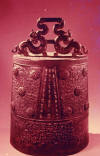|
The Zhou Dynasty
"Around 1050 B.C., the Zhou, whose dynasty endured until 256
B.C., overthrew the Shang kingdom. The
very earliest Zhou art is nearly indistinguishable from that of the
Shang, and some artists probably worked for
both dynasties. Within a generation, however, changes in vessel shapes
already had occurred, and by the fourth century B.C., Zhou bronzes featured
entirely new designs - scenes of hunting, religious rites, and magic practices.
These may relate to the subjects and compositions of lost paintings mentioned in
Zhou literature. ... Zhou artists produced objects in great quantity to satisfy
the elaborate demands of ostentatious feudal courts vying with one another in
lavish display."
- Gardner's
Art Through The Ages,
11th edition, Vol. I, p. 192

This bronze serving vessel has a detachable lid which can be
flipped to be used as a serving or dining platter.

This cooking pot exemplifies the zoomorphic elements of Shang
and Zhou bronze design. Like the other bronzes on this page, this cooking
pot was recovered from a burial site where it was used as a ceremonial item for
the afterlife.

This wine vessel exemplifies the superb craftsmanship and
creative yet utilitarian elements of the design. The horns and tail
function as handles, the nose ring acts as a spout, while the small creature on
the vessel's back acts as a handle for opening the vessel and pouring the hot
(spiced) wine into it.

This Zhou ceremonial bell contains an inscription in
ancient Chinese characters which identify the tomb from which it was exhumed.
Ceremonial bells have been the primary musical instrument type which have been
found from the Shang and Zhou dynasties.
|